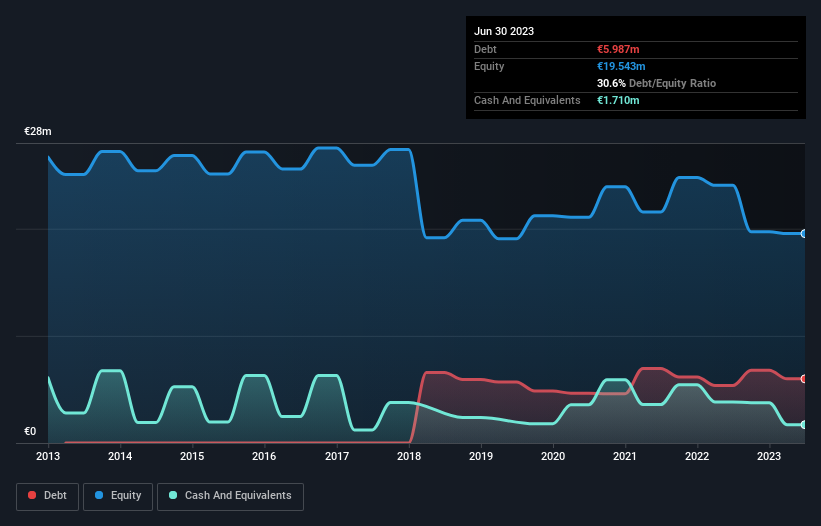
Legendary fund manager Li Lu (who Charlie Munger backed) once said, 'The biggest investment risk is not the volatility of prices, but whether you will suffer a permanent loss of capital.' It's only natural to consider a company's balance sheet when you examine how risky it is, since debt is often involved when a business collapses. We can see that Koninklijke Brill NV (AMS:BRILL) does use debt in its business. But the real question is whether this debt is making the company risky.
When Is Debt Dangerous?
Debt assists a business until the business has trouble paying it off, either with new capital or with free cash flow. In the worst case scenario, a company can go bankrupt if it cannot pay its creditors. However, a more common (but still painful) scenario is that it has to raise new equity capital at a low price, thus permanently diluting shareholders. Having said that, the most common situation is where a company manages its debt reasonably well - and to its own advantage. When we examine debt levels, we first consider both cash and debt levels, together.
See our latest analysis for Koninklijke Brill
What Is Koninklijke Brill's Net Debt?
As you can see below, at the end of June 2023, Koninklijke Brill had €5.99m of debt, up from €5.36m a year ago. Click the image for more detail. However, because it has a cash reserve of €1.71m, its net debt is less, at about €4.28m.

A Look At Koninklijke Brill's Liabilities
Zooming in on the latest balance sheet data, we can see that Koninklijke Brill had liabilities of €25.2m due within 12 months and liabilities of €14.0m due beyond that. Offsetting this, it had €1.71m in cash and €8.83m in receivables that were due within 12 months. So it has liabilities totalling €28.7m more than its cash and near-term receivables, combined.
This deficit isn't so bad because Koninklijke Brill is worth €49.1m, and thus could probably raise enough capital to shore up its balance sheet, if the need arose. But it's clear that we should definitely closely examine whether it can manage its debt without dilution. There's no doubt that we learn most about debt from the balance sheet. But you can't view debt in total isolation; since Koninklijke Brill will need earnings to service that debt. So when considering debt, it's definitely worth looking at the earnings trend. Click here for an interactive snapshot.
Over 12 months, Koninklijke Brill made a loss at the EBIT level, and saw its revenue drop to €49m, which is a fall of 5.6%. That's not what we would hope to see.
Caveat Emptor
Over the last twelve months Koninklijke Brill produced an earnings before interest and tax (EBIT) loss. Indeed, it lost €3.9m at the EBIT level. When we look at that and recall the liabilities on its balance sheet, relative to cash, it seems unwise to us for the company to have any debt. Quite frankly we think the balance sheet is far from match-fit, although it could be improved with time. Another cause for caution is that is bled €1.5m in negative free cash flow over the last twelve months. So suffice it to say we do consider the stock to be risky. There's no doubt that we learn most about debt from the balance sheet. But ultimately, every company can contain risks that exist outside of the balance sheet. For instance, we've identified 3 warning signs for Koninklijke Brill (2 are significant) you should be aware of.
If you're interested in investing in businesses that can grow profits without the burden of debt, then check out this free list of growing businesses that have net cash on the balance sheet.
Valuation is complex, but we're here to simplify it.
Discover if Koninklijke Brill might be undervalued or overvalued with our detailed analysis, featuring fair value estimates, potential risks, dividends, insider trades, and its financial condition.
Access Free AnalysisHave feedback on this article? Concerned about the content? Get in touch with us directly. Alternatively, email editorial-team (at) simplywallst.com.
This article by Simply Wall St is general in nature. We provide commentary based on historical data and analyst forecasts only using an unbiased methodology and our articles are not intended to be financial advice. It does not constitute a recommendation to buy or sell any stock, and does not take account of your objectives, or your financial situation. We aim to bring you long-term focused analysis driven by fundamental data. Note that our analysis may not factor in the latest price-sensitive company announcements or qualitative material. Simply Wall St has no position in any stocks mentioned.
About ENXTAM:BRILL
Koninklijke Brill
Operates as a publishing house in Western Europe, North America, the Asia Pacific, and internationally.
Mediocre balance sheet with weak fundamentals.


